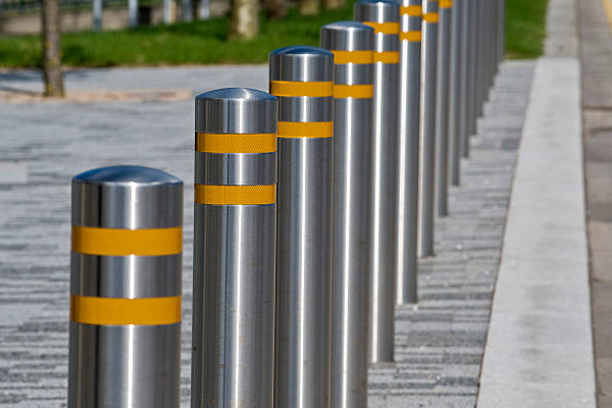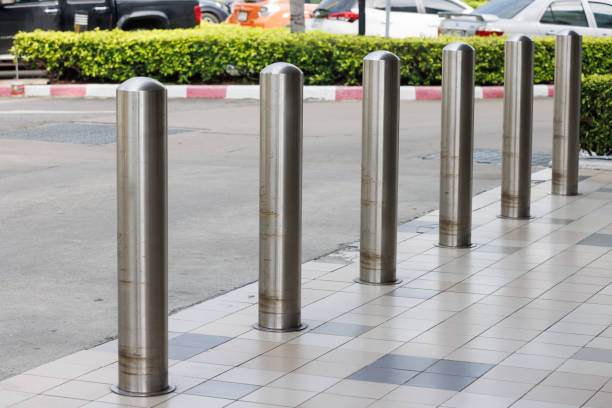About The Bollards
Bollards have many possible uses. Sysinfra Scientific bollards are typically used for one or more of the following purposes:
- Safety: Every day, there are up to 60 incidents of a vehicle crashing into a storefront. These low-impact crashes are usually accidental.
- Security: Sometimes bad actors crash vehicles into buildings or pedestrian areas on purpose. Sometimes these are “smash-and-grab” burglaries in which the criminals use the crash as a means of getting into the building. Though resulting in significant property damage, these smash-and-grab incidents usually happen after business hours and result in few injuries or deaths. More recently, terrorists have launched attacks against civilians by crashing large vehicles into buildings or designated pedestrian areas in a deliberate attempt to cause injuries
- Pedestrian Guides: In addition to keeping pedestrians safe, bollards can also act as directional guides showing them where they are allowed to walk.


Visual guides for traffic and landscaping
Traffic line or street bollards
- Traffic bollards are used to guide traffic toward appropriate areas while ensuring clear sight lines and allowing pedestrian access. They guide cars by creating roadway demarcation, or prevent access to restricted areas like bike lanes, public squares, and traffic islands. On roadways without curbs, they can be used to prevent vehicles straying from the street. Sometimes they are used in association with other traffic calming methods, like speed humps or one-way streets, to prevent vehicles from attempting to avoid other traffic management elements. Architectural bollards such as these are most commonly used in public spaces.
Pedestrian bollards
- In many landscapes and properties, decorative bollards are used to define distinct pedestrian areas. A line of them around a building may define its perimeter and add architectural flair. Perimeters can also be made around a playground or park, allowing easy access but discouraging its use as a throughway. When linked with chain, bollards can encourage pedestrians to stay on marked paths, without forming a closed barrier that prevents all crossing. Lighted versions illuminate pedestrian pathways at night. Solar powered lighting is becoming the most frequently used form of lighting bollard, since each unit functions on its own with very little maintenance. Our gallery of landscape bollards highlights the range of options available.
Construction bollards
- On roadway construction zones, temporary posts are often placed to define and protect the work area from traffic. These delimiters are usually made of flexible brightly colored plastic ringed in reflective tape, and sit on removable rubber bases. They are usually spaced closely, to provide a continual visual edge to the oncoming traffic.
Bike lane separation
- Separated bike lanes offer safety to cyclists and lower driver stress. They encourage more cyclists to the road. However, flimsy delimiters are often ripped off when run over, leaving cyclists vulnerable. Hard boundaries can prevent emergency vehicles from reaching the curb. Tough flexible bollards, made of polyurethane, are a better solution. Check out the options in substantial flexible bollards for bike lanes (as well as parking lots and lane delimiters).
Bike lane separation
- Separated bike lanes offer safety to cyclists and lower driver stress. They encourage more cyclists to the road. However, flimsy delimiters are often ripped off when run over, leaving cyclists vulnerable. Hard boundaries can prevent emergency vehicles from reaching the curb. Tough flexible bollards, made of polyurethane, are a better solution. Check out the options in substantial flexible bollards for bike lanes (as well as parking lots and lane delimiters).
Security bollards
- Security bollards are also visual guides to pedestrians and traffic, but are additionally built to resist vehicle impact. These are often made of steel and filled with concrete, but can be decorated with a fine finish or a cover. In general, the local substrate and installation are essential parts of impact resistance: a strong bollard set poorly will offer little resistance. Engineering oversight is therefore essential. Different applications will also have different impact resistance needs. Check out security options.
Protecting people
- Playgrounds near parking lots, parks beside sharp bends in the road, outdoor patios by busy roadways: these are just some of the places that security bollards might help prevent an accident from becoming a tragedy. Steel-and-concrete is available in a variety of widths that should be matched to the vehicle speeds and distance of pedestrian zone to roadway. They are usually covered with sleeves or covers for corrosion protection and attractiveness. Check out bollard cover options.
Protecting vulnerable building components
- Safety bollards are often installed in front of vulnerable building components to minimize damage in the event of an accident. They are not usually designed with the idea there will be purposeful attack against them, so are often specified with suggested diameters of steel pipe to be filled with concrete. In some jurisdictions, vulnerable gas or water meters are required to have security bollards in bright colors installed as barrier posts around them. They are also often placed in front of vulnerable or historical architectural features close to traffic to protect against accident. They are not used for places likely to attract attack. See the range of safety bollards in bright colors.
Protecting vulnerable building components
- Safety bollards are often installed in front of vulnerable building components to minimize damage in the event of an accident. They are not usually designed with the idea there will be purposeful attack against them, so are often specified with suggested diameters of steel pipe to be filled with concrete. In some jurisdictions, vulnerable gas or water meters are required to have security bollards in bright colors installed as barrier posts around them. They are also often placed in front of vulnerable or historical architectural features close to traffic to protect against accident. They are not used for places likely to attract attack. See the range of safety bollards in bright colors.

